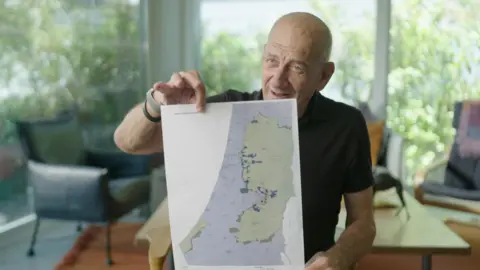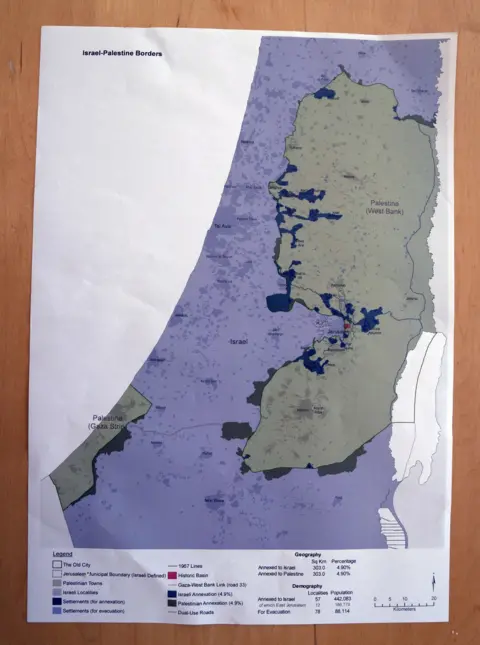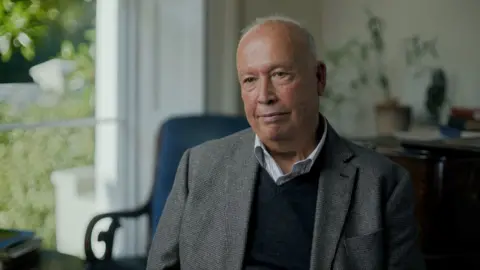The unseen map that promised to bring peace to the Middle East
 BBC
BBC"In the next 50 years, you will not find one Israeli leader that will propose to you what I propose to you now.
"Sign it! Sign it and let's change history!"
It was 2008. Israel's Prime Minister Ehud Olmert was imploring the Palestinian leader to accept a deal he believed could have brought peace to the Middle East.
It was a two-state solution - a prospect which seems impossible today.
If implemented, it would have created a Palestinian state on more than 94% of the occupied West Bank.
The map Olmert had drawn up now has an almost mythical status. Various interpretations have appeared over the years, but he has never revealed it to the media.
Until now.

In Israel and the Palestinians: The Road to 7th October, the latest series from documentary filmmaker Norma Percy available on iPlayer from Monday, Olmert reveals the map he says he showed to Mahmoud Abbas at a meeting in Jerusalem on 16 September 2008.
"This is the first time that I expose this map to the media," he tells the filmmakers.
It shows, in detail, the territory which Olmert proposed to annexe to Israel - 4.9% of the West Bank.
That would have included major Jewish settlement blocs - just like previous proposals dating back to the late 1990s.
In return, the prime minister said Israel would give up an equal amount of Israeli territory, along the edges of the West Bank and Gaza Strip.
The two Palestinian territories would be connected via a tunnel or highway – again, something that had been discussed before.
In the film, Olmert recalls the Palestinian leader's response.
"He said: 'Prime minister, this is very serious. It is very, very, very serious.'"
Crucially, Olmert's plan included a proposed solution to the thorny issue of Jerusalem.
Each side would be able to claim parts of the city as their capital, while administration of the "holy basin" - including the Old City, with its religious sites, and adjacent areas - would be handed over to a committee of trustees consisting of Israel, Palestine, Saudi Arabia, Jordan and the US.
The implications of the map, for Jewish settlements, would have been colossal.
Had the plan been implemented, dozens of communities, scattered throughout the West Bank and Jordan Valley, would have been evacuated.
When the previous Israeli prime minister, Ariel Sharon, forcibly removed a few thousand Jewish settlers from the Gaza Strip in 2005, it was regarded as a national trauma by those on the Israeli right.
Evacuating most of the West Bank would have represented an infinitely greater challenge, involving tens of thousands of settlers, with the very real danger of violence.
But the test never came.
At the end of their meeting, Olmert refused to hand over a copy of the map to Mahmoud Abbas unless the Palestinian leader sign it.
Abbas refused, saying that he needed to show his experts the map, to make sure they understood exactly what was being offered.
Olmert says the two agreed to a meeting of map experts the following day.
"We parted, you know, like we are about to embark on a historic step forward," Olmert says.
The meeting never happened. As they drove away from Jerusalem that night, President Abbas's chief of staff, Rafiq Husseini, remembers the atmosphere in the car.
"Of course, we laughed," he says in the film.
The Palestinians believed the plan was dead in the water. Olmert, embroiled in an unrelated corruption scandal, had already announced that he was planning to resign.
"It is unfortunate that Olmert, regardless of how nice he was… was a lame duck," Husseini says, "and therefore, we will go nowhere with this."
The situation in Gaza also complicated matters. After months of rocket attacks from the Hamas-controlled territory, Olmert ordered a major Israeli assault, Operation Cast Lead, at the end of December, triggering three weeks of intense fighting.
But Olmert tells me it would have been "very smart" for Abbas to sign the deal. Then, if a future Israeli prime minister tried to cancel it, "he could have said to the world that the failure was Israel's fault".

Israeli elections followed in February. Likud's Benjamin Netanyahu, a vocal opponent of Palestinian statehood, became prime minister.
Olmert's plan, and map, faded from view.
The former prime minister says he's still waiting for Abbas's reply, but his plan has since joined a long list of missed opportunities to end the Israeli-Palestinian conflict.
In 1973, the former Israeli diplomat, Abba Eban, quipped that the Palestinians "never miss an opportunity to miss an opportunity". It's a phrase that Israeli officials have frequently repeated in the years since.
But the world is more complicated than that, especially since the two sides signed the historic Oslo Accords in 1993.
The peace process ushered in by a handshake on the White House lawn between former Israeli prime minister Yitzhak Rabin and Palestinian leader Yasser Arafat had moments of genuine hope, punctuated by tragedy. Ultimately, it resulted in failure.
The reasons are complex and there's plenty of blame to go around but in truth, the stars were never properly aligned.
I witnessed this non-alignment at first hand 24 years ago.
In January 2001, at the Egyptian resort of Taba, Israeli and Palestinian negotiators once again saw the outlines of a deal.
A member of the Palestinian delegation drew a rough map on a napkin and told me that, for the first time, they were looking at the rough outlines of a viable Palestinian state.
But the talks were irrelevant, drowned out by the violence raging on the streets of the West Bank and Gaza, where the second Palestinian uprising, or "intifada", had erupted the previous September.
Once again, Israel was in the midst of a political transition. Prime Minister Ehud Barak had already resigned. Ariel Sharon comfortably defeated him a few weeks later.
The map on the napkin, just like Olmert's map eight years later, showed what might have been.
